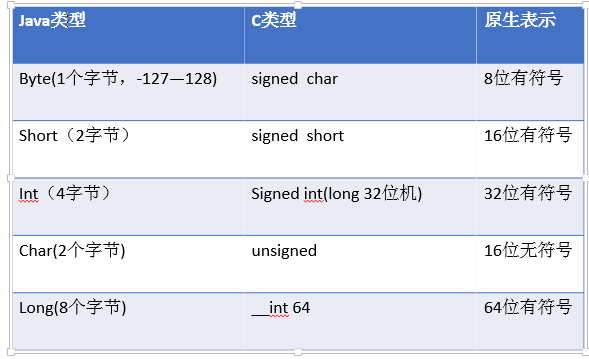一、前言
Jna调用的示范,基本包括了Java->C基本类型的转换,指针的转换等。
不过文章是2011年的,可能后面要查看下有什么改变。
二、原文
http://www.viaboxxsystems.de/java-interoperation-with-a-native-dll-using-jna
推荐实例阅读:http://www.eshayne.com/jnaex/index.html
三、翻译
大体翻译。
从Java调用dll,你可以选择JNI和JNA。(还有其他了.......)
关于调用转换
首先定义接口,接口继承““com.sun.jna.Library” 或者 “com.sun.jna.win32.StdCallLibrary”.”。
 View Code
View Code
Java中调用如下:
View Code
基本数据转换
上述方法中,“returnDllVersion”方法返回一个char *(C语言),JNA框架将char *转换为Java String(Unicode)。JNA提供了大部分的JAVA/C数据类型的转换,可参见“Mapping between Java and Native“.
注:此段后为自己加的内容,可能有误。
由于我在数据转换时涉及到了很多unsigned,signed的问题,之前基础也不好,对Java/C的数据类型就一并进行了一些学习,记录在此块。
首先,signed和unsigned区别:最高位是否符号位,参见http://www.eefocus.com/utoo/blog/10-03/186828_7076c.html
java的基本数据类型理解:这篇是看源码分析的,简单明了。参见http://www.cnblogs.com/xiaoQLu/archive/2013/04/08/3009142.html
首先可以看出,对于Java来说大多是sighed类型的,除了java char,java char为2字节,byte才为1字节相当于C中的char。
简单的一个小表,Java的类型首字母大写无视吧......小表只是自己分析过程的一个记录......
具体表可见JNA官方Mapping,Mapping between Java and Native.

所以,我对网上的一些对C函数中unsigned int 的有些说转成Java long或者Java int的做法不是很理解。对于存储来说,计算机存储的unsighed int就是32位,转换为Java long64位读取不会越界?转换为Java int读取的话如果涉及到最高位符号位的,按照Java int有符号的读取怎么会正确?
输出到共享内存
C++: EXAMPLE_DLL bool readBufferContent(unsigned char* outbuf); Java: boolean readBufferContent(Memory memory);
C函数”readBufferContent"将字符串输出到内存中,Java调用这函数读取等,如果写入字符串的最大长度已知,则可如下操作:
1.Java请求分配内存,以byte为单位
Memory memory = new Memory(100);
2.Java调用执行,以memory为参数
ExampleDLL.INSTANCE.readBufferContent(memory);
3.C++写入,返回
4.Java读取内存,获得写入字符串
String bufferContent = memory.getString(0);
5.当这块内存的引用为0是,Java垃圾回收机制自动回收此空间。
int 类型输出参数:call-by-reference
C++: EXAMPLE_DLL ResultStruct* consolidate(const short *cardTypes, int *numberOfResults); Java: Pointer consolidate(int[] cardTypes, IntByReference numberOfResults);
这个实例演示了如下几个问题:
1. C中第一个参数为int数组(short 16位为什么会是int数组?),JNA中提供了简单数组转换,参见JNA文档 “Pointers and Arrays“。
2. 第二个变量为输出变量,Dll把结果写入numberOfResults变量中,参数类型为int *,传入int变量地址。JNA提供了丰富的ByReference类来实现地址传参,如“com.sun.jna.ptr.IntByReference”.Java中如下可访问该地址,获取数据。
int value = numberResults.getValue();
3. 返回为结构体指针,对于这个指针不能像IntByReference一样确定该指针指向的空间大小。
动态数组指针
之前的方法中,C返回数组指针,数组元素类型为结构体ResultStruct,JNA不能自动转换结构体。但是可以将C结构体转换为Java Object类,结合JNA提供的数组转换,来完成结构体数组的转换。
我们要解决2个问题:
- 如何为结构体数组分配和释放动态内存?
- 如何构造Java Object类?
由于在函数调用前我们无法获知数组长度,所以无法确定需要的内存大小,所以不能在JNA中分配固定大小的内存。C++使用malloc()和new()来分配heap memory,DLL中必须提供单独的freeMemory()函数来实现内存的释放。
C++: void freeMemory(ResultStruct *arr) { if(arr) delete[] arr; } Java: void freeMemory(Pointer p);
由于DLL自身使用了单独的heap-Manager,Java程序不能释放这段内存,进一步讨论可参见 in a C++ forum。
后面是结构体的转换等,过了一遍不翻译。
Create Java objects from array of C-structs
We map the return type of the function as a com.sun.jna.Pointer in Java. With the knowledge about the C-struct (sequence and data type of member variables), the java program can read and convert the memory content to create adequate objects. The number of elements in the array is also known (variable “numberOfResults”, see above). It is very important, to compute the offset correctly to avoid JVM-crashes for invalid memory access!
C++:
struct ResultStruct {
unsigned short count;
char description[40];
unsigned short average;
};
Java:
public static class ResultStruct {
public short count;
public String description;
public short average;
}
static ResultStruct[] fromArrayPointer(Pointer pointer, int numberResults) {
ResultStruct[] arr = new ResultStruct[numberResults];
int offset = 0;
for (int i = 0; i < numberResults; i++) {
arr[i] = fromPointer(pointer, offset);
offset += 44;
}
return arr;
}
static ResultStruct fromPointer(Pointer pointer, int offset) {
ResultStruct inst = new ResultStruct();
inst.count = pointer.getShort(offset);
offset += 2;
inst.description = pointer.getString(offset);
offset += 40;
inst.average = pointer.getShort(offset);
return inst;
}
Callback functions (Call a Java method from within the C++ DLL)
In places, where C gets a function pointer to call a function, this can be used to call Java methods as well. JNA offers a Callback-interface, documented in chapter “Callbacks/Closures“. The Callback class inherits form the Callback interface and contains a single method of arbitrary name and with compatible signature.
C++:
EXAMPLE_DLL void setFunction(void (*func)(char **texts, int count));
Java:
void setFunction(ExampleCallback callback);
public interface ExampleCallback extends Callback {
void receive(Pointer pointerToTexts, int count);
}
Convert a char** into a String-array
Finally, a look at the signature of the “receive” method in the ExampleCallback interface. It gets a string-array in form of a pointer to a pointer, char **. Because of the differences between C-strings and Java-strings, you should use the method Pointer.getStringArray(int,int) provided by JNA to do the conversion. No care needs to be taken of memory usage, because the memory for the strings has been allocated by the C-DLL and the call happens from inside the DLL, so the C-program is responsible to free the memory when the callback returns. The java-strings copy the memory content and are completly decoupled from the c-strings.
public void receive(Pointer pointerToTexts, int count) {
String[] texts = pointerToTexts.getStringArray(0, count);
...
}
四、小节
long WINAPI AutoOpenComPort(long* Port, unsigned char *ComAdr, unsigned char Baud,long *FrmHandle);
分析下我自己需要的转换,32位机。
long *:之前直接用pointer指向4字节,传参pointer.应该可以直接用intbyrefrence. 想想其实实质也没差别啊
unsigned char *:就是String, byte[]?
unsigned char:byte.
理解上是不是所有指针传参都可以用pointer完成,获取看看源码怎么实现就知道了。